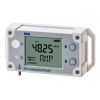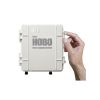HOBO Remote Head Air Velocity and Temperature Sensor
Features
- Allows for the measurement of air velocity in ducts
- Expedited repair and warranty service
- Lifetime technical support
- More
Overview
The F350 series is a versatile, high performance, air velocity and air temperature sensor where the sensor element is built remotely from the sensor electronics. In products where segregation of the sensing element and electronics is desirable, such as products involving high EMI sensitivity or extreme temperature, or those where the sensing area is too small for typical probe-style sensors.
Requirements (Logger Specific)
- HOBO RX3000: an analog input module (RXMOD-A1)
- HOBO U30: an analog input module (VIA)
- HOBO H22: an analog input module (S-FS-CVIA)
- HOBO U120 data logger: 0-5 Volt DC input cable (CABLE-ADAP5) and external power provided by an AC adapter (AC-SENS-1)
- Operating temperature range: 0°C to 60°C (32°F to 140°F)
- Velocity range: 0.15 to 1.0 m/s (30 to 200 fpm)
0.5 to 10 m/s (100 to 2,000 fpm)
1.0 to 20 m/s (200 to 4,000 fpm) - Response time: 400ms
- Storage temperature: -40°C to 105°C (-40°F - 220°F)
- Relative humidity (non-condensing): 5-95%
- Supply power requirements: 4.5-15 VDC, 35mA nominal
- Velocity Output: 0-5V
- Temperature output: 0-5V
- Housing Construction: Polycarbonate (PC), UL94-V0 (head) UL94-HB (housing)
- Plenum rated cable: 22 AWG
- Environmental Protection: IP65 electronics, including conformal coated sensing element
- Accuracy: 0.15 to 1.0 m/s (30 to 200 fpm): ± (1% of reading + 0.05 m/s [10 fpm])
0.5 to 10 m/s (100 to 2,000 fpm): ± (4% of reading + 0.10 m/s [20 fpm])
1.0 to 20 m/s (200 to 4,000 fpm): ± (5% of reading + 0.15 m/s [30 fpm]) - Stainless Steel Wand: 127mm (5")
- Sensor Head Height: 64mm (.25")
- Housing Length: 196 mm [7.75"]
- Cable Length from Housing to Sensor Head: 1m [3']
In The News
Wave-Powered Buoy Deployed in Puget Sound
While the development of solar-powered monitoring systems has improved access to real-time environmental data, solar power is still limited by low light conditions, such as poor weather, nighttime, or high-latitude environments. To supplement these incumbent power solutions at sea, Ocean Motion Technologies has developed a small-scale ocean wave energy system that can be directly integrated with existing data buoy platforms. Not only does wave energy supplement solar power during periods when the buoys are limited by light availability, but it also allows data buoys to perform beyond their current power capacities.
Read MoreLong-Term Monitoring in the Chautauqua Lake Watershed
With a widely developed shoreline, Chautauqua Lake experiences influxes of non-point source pollution that have historically impacted the health of the lake. The Chautauqua Lake Association (CLA) has been monitoring the lake for over two decades, reporting on changes that have occurred over the years. A pair of local lake advocates, Jane and Doug Conroe, have lived on the lake for over 40 years and have played an important role in establishing monitoring programs and facilitating consistent data collection throughout the watershed. Doug has been involved with the Chautauqua Lake Association (CLA) since the pair moved to the area in 1980, and is currently serving as the Executive Director.
Read MoreNo Red Herrings: Data Driving the Largest Salt Marsh Restoration in the NE USA
The Herring River system encompasses around 1,000 acres in the Towns of Wellfleet and Truro, Massachusetts. In 1909, the Chequessett Neck Road dike was built at the river’s mouth, drastically limiting tidal flow. Today, it’s one of the most restricted estuaries in the northeastern United States. As a result, the area has suffered environmental decline, including poor water quality, hypoxia, lower pH, and salt marsh degradation. In 2023, the Town of Wellfleet received $14.7 million from NOAA’s Office of Habitat Conservation to fund the Herring River Restoration Project (HRRP). Francesco Peri, President and CEO at Charybdis Group LLC, uses a network of NexSens data loggers to monitor water level and water quality on the Herring River.
Read More










